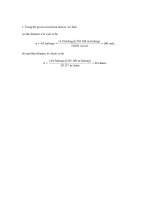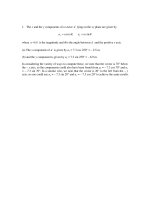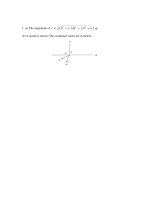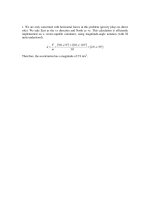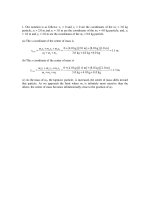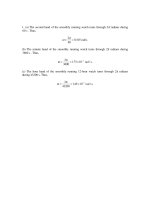Solution manual fundamentals of physics extended, 8th editionch13
Bạn đang xem bản rút gọn của tài liệu. Xem và tải ngay bản đầy đủ của tài liệu tại đây (951.44 KB, 108 trang )
1. The magnitude of the force of one particle on the other is given by F = Gm1m2/r2,
where m1 and m2 are the masses, r is their separation, and G is the universal gravitational
constant. We solve for r:
Gm1m2
=
r=
F
( 6.67 ×10
−11
N ⋅ m 2 / kg 2 ) ( 5.2kg )( 2.4kg )
2.3 × 10−12 N
= 19 m
2. We use subscripts s, e, and m for the Sun, Earth and Moon, respectively.
Gms mm
2
Fsm
rsm2
ms § rem ·
=
=
¨ ¸
Fem Gme mm me © rsm ¹
rem2
Plugging in the numerical values (say, from Appendix C) we find
2
1.99 ×1030 § 3.82 × 108 ·
¨
¸ = 2.16.
5.98 ×10 24 © 1.50 × 1011 ¹
3. The gravitational force between the two parts is
F=
Gm ( M − m ) G
= 2 ( mM − m 2 )
2
r
r
which we differentiate with respect to m and set equal to zero:
dF
G
= 0 = 2 ( M − 2m ) M = 2m
dm
r
which leads to the result m/M= 1/2.
4. Using F = GmM/r2, we find that the topmost mass pulls upward on the one at the
origin with 1.9 × 10−8 N, and the rightmost mass pulls rightward on the one at the origin
with 1.0 × 10−8 N. Thus, the (x, y) components of the net force, which can be converted to
polar components (here we use magnitude-angle notation), are
&
Fnet = (1.04 × 10−8 ,1.85 × 10−8 ) ( 2.13 × 10−8 ∠ 60.6° ) .
(a) The magnitude of the force is 2.13 × 10−8 N.
(b) The direction of the force relative to the +x axis is 60.6° .
5. At the point where the forces balance GM e m / r12 = GM s m / r22 , where Me is the mass of
Earth, Ms is the mass of the Sun, m is the mass of the space probe, r1 is the distance from
the center of Earth to the probe, and r2 is the distance from the center of the Sun to the
probe. We substitute r2 = d − r1, where d is the distance from the center of Earth to the
center of the Sun, to find
Me
Ms
=
.
2
2
r1
( d − r1 )
Taking the positive square root of both sides, we solve for r1. A little algebra yields
r1 =
d Me
Ms + Me
(150 ×10 m )
9
=
5.98 × 1024 kg
1.99 × 10 kg + 5.98 ×10 kg
30
Values for Me, Ms, and d can be found in Appendix C.
24
= 2.60 × 108 m.
6. The gravitational forces on m5 from the two 5.00g masses m1 and m4 cancel each other.
Contributions to the net force on m5 come from the remaining two masses:
Fnet
( 6.67 ×10
=
−11
N ⋅ m 2 /kg 2 )( 2.50 ×10−3 kg )( 3.00 ×10−3 kg − 1.00 ×10−3 kg )
(
2 × 10−1 m
)
2
= 1.67 × 10−14 N.
The force is directed along the diagonal between m2 and m3, towards m2. In unit-vector
notation, we have
&
Fnet = Fnet (cos 45°ˆi + sin 45°ˆj) = (1.18 × 10−14 N) ˆi + (1.18 ×10−14 N) ˆj
7. We require the magnitude of force (given by Eq. 13-1) exerted by particle C on A be
equal to that exerted by B on A. Thus,
GmA mC
GmA mB
=
.
2
r
d2
We substitute in mB = 3mA and mB = 3mA, and (after canceling “mA”) solve for r. We
find r = 5d. Thus, particle C is placed on the x axis, to left of particle A (so it is at a
negative value of x), at x = –5.00d.
8. (a) We are told the value of the force when particle C is removed (that is, as its
position x goes to infinity), which is a situation in which any force caused by C vanishes
(because Eq. 13-1 has r2 in the denominator). Thus, this situation only involves the force
exerted by A on B:
GmA mB
−10
(0.20 m)2 = 4.17 × 10 N .
Since mB = 1.0 kg, then this yields mA = 0.25 kg.
(b) We note (from the graph) that the net force on B is zero when x = 0.40 m. Thus, at
that point, the force exerted by C must have the same magnitude (but opposite direction)
as the force exerted by A (which is the one discussed in part (a)). Therefore
GmC mB
−10
(0.40 m)2 = 4.17 × 10 N
mC = 1.00 kg.
9. (a) The distance between any of the spheres at the corners and the sphere at the center
is r = " / 2 cos 30° = " / 3 where " is the length of one side of the equilateral triangle.
The net (downward) contribution caused by the two bottom-most spheres (each of mass
m) to the total force on m4 has magnitude
Gm m
§ Gm m ·
2 Fy = 2 ¨ 24 ¸ sin 30° = 3 24 .
"
© r ¹
This must equal the magnitude of the pull from M, so
3
Gm4 m
Gm4 m
=
2
2
"
"/ 3
(
)
which readily yields m = M.
(b) Since m4 cancels in that last step, then the amount of mass in the center sphere is not
relevant to the problem. The net force is still zero.
10. All the forces are being evaluated at the origin (since particle A is there), and all
→
forces (except the net force) are along the location-vectors r which point to particles B
and C. We note that the angle for the location-vector pointing to particle B is 180º –
30.0º = 150º (measured ccw from the +x axis). The component along, say, the x axis of
→
one of the force-vectors F is simply Fx/r in this situation (where F is the magnitude of
→
F ). Since the force itself (see Eq. 13-1) is inversely proportional to r2 then the
aforementioned x component would have the form GmMx/r3; similarly for the other
components. With mA = 0.0060 kg, mB = 0.0120 kg, and mC = 0.0080 kg, we therefore
have
Fnet x =
GmAmB xB
GmAmC xC
+
= (2.77 × 10−14 N)cos(−163.8º)
3
rB
rC 3
Fnet y =
GmAmB yB
GmAmC yC
+
= (2.77 × 10−14 N)sin(−163.8º)
3
rB
rC 3
and
where rB = dAB = 0.50 m, and (xB, yB) = (rBcos(150º), rBsin(150º)) (with SI units
understood). A fairly quick way to solve for rC is to consider the vector difference
between the net force and the force exerted by A, and then employ the Pythagorean
theorem. This yields rC = 0.40 m.
(a) By solving the above equations, the x coordinate of particle C is xC = −0.20 m.
(b) Similarly, the y coordinate of particle C is yC = −0.35 m.
11. If the lead sphere were not hollowed the magnitude of the force it exerts on m would
be F1 = GMm/d2. Part of this force is due to material that is removed. We calculate the
force exerted on m by a sphere that just fills the cavity, at the position of the cavity, and
subtract it from the force of the solid sphere.
The cavity has a radius r = R/2. The material that fills it has the same density (mass to
volume ratio) as the solid sphere. That is Mc/r3= M/R3, where Mc is the mass that fills the
cavity. The common factor 4π/3 has been canceled. Thus,
§ r3 ·
§ R3 ·
M
Mc = ¨ 3 ¸ M = ¨ 3 ¸ M = .
8
©R ¹
© 8R ¹
The center of the cavity is d − r = d − R/2 from m, so the force it exerts on m is
F2 =
G ( M/8 ) m
( d − R/2 )
2
.
The force of the hollowed sphere on m is
§ 1
· GMm §
·
1
1
−
F = F1 − F2 = GMm ¨ 2 −
=
1
¸
¨
¸
2
2
¨d
¸
¨ 8 (1 − R/2d )2 ¸
d
−
8
d
R
/2
(
)
©
¹
©
¹
=
·
(6.67 × 10−11 m3 /s 2 ⋅ kg)(2.95 kg)(0.431 kg) §
1
¨1 −
2
2 ¸
−2
−2
−2
(9.00 × 10 m)
© 8[1 − (4 × 10 m) /(2 ⋅ 9 ×10 m)] ¹
= 8.31×10 −9 N.
12. Using Eq. 13-1, we find
→
FAB =
2GmA2 ^
d2 j
and
→
4GmA2 ^
FAC = – 3d2 i .
Since the vector sum of all three forces must be zero, we find the third force (using
magnitude-angle notation) is
→
FAD
GmA2
= d2 (2.404 ∠ –56.3º) .
→
This tells us immediately the direction of the vector r (pointing from the origin to
particle D), but to find its magnitude we must solve (with mD = 4mA) the following
equation:
2
GmAmD
§GmA ·
2.404¨ d2 ¸ =
.
r2
¹
©
→
This yields r = 1.29d. In magnitude-angle notation, then, r = (1.29 ∠ –56.3º) , with
SI units understood. The “exact” answer without regard to significant figure
considerations is
→
r = ( 2
6
13 13
, –3
6
13 13
(a) In (x, y) notation, the x coordinate is x =0.716d.
(b) Similarly, the y coordinate is y = −1.07d.
).
13. All the forces are being evaluated at the origin (since particle A is there), and all
→
forces are along the location-vectors r which point to particles B, C and D. In three
dimensions, the Pythagorean theorem becomes r = x2 + y2 + z2 . The component along,
→
say, the x axis of one of the force-vectors F is simply Fx/r in this situation (where F is
→
the magnitude of F ). Since the force itself (see Eq. 13-1) is inversely proportional to r2
then the aforementioned x component would have the form GmMx/r3; similarly for the
other components. For example, the z component of the force exerted on particle A by
particle B is
GmA mB zB
GmA(2mA)(2d)
4GmA2
= ((2d)2 + d2 + (2d)2)3 = 27 d2 .
rB3
In this way, each component can be written as some multiple of GmA2/d2. For the z
component of the force exerted on particle A by particle C, that multiple is –9 14 /196.
For the x components of the forces exerted on particle A by particles B and C, those
multiples are 4/27 and –3 14 /196 and , respectively. And for the y components of the
forces exerted on particle A by particles B and C, those multiples are 2/27 and 3 14 /98
and , respectively. To find the distance r to particle D one method is to solve (using the
fact that the vector add to zero)
2 2
2
§GmAmD·
§GmA ·
¨ r2 ¸ = [(4/27 –3 14 /196)2 + (2/27 +3 14 /98)2 + (4/27 –9 14 /196)2] ¨ d2 ¸
¹
©
©
¹
(where mD = 4mA) for r. This gives r = 4.357d. The individual values of x, y and z
(locating the particle D) can then be found by considering each component of the
GmAmD/r2 force separately.
&
(a) The x component of r would be
GmA mD x/r3 = –(4/27 –3 14 /196)GmA2/d2,
which yields x = –1.88d.
(b) Similarly, y = −3.90d,
(c) and z = 0.489d.
In this way we are able to deduce that (x, y, z) = (−1.88d, −3.90d, 0.49d).
14. We follow the method shown in Sample Problem 13-3. Thus,
ag =
GM E
GM
dag = −2 3 E dr
2
r
r
which implies that the change in weight is
Wtop − Wbottom ≈ m ( dag ) .
But since Wbottom = GmME/R2 (where R is Earth’s mean radius), we have
mdag = −2
GmM E
dr
1.61×103 m
−
−
= −0.303 N
dr
=
2
W
=
2
600
N
(
)
bottom
R3
R
6.37 ×106 m
for the weight change (the minus sign indicating that it is a decrease in W). We are not
including any effects due to the Earth’s rotation (as treated in Eq. 13-13).
15. The acceleration due to gravity is given by ag = GM/r2, where M is the mass of Earth
and r is the distance from Earth’s center. We substitute r = R + h, where R is the radius
of Earth and h is the altitude, to obtain ag = GM /(R + h)2. We solve for h and obtain
h = GM / ag − R . According to Appendix C, R = 6.37 × 106 m and M = 5.98 × 1024 kg,
so
h=
( 6.67 ×10
−11
m 3 / s 2 ⋅ kg )( 5.98 × 1024 kg )
( 4.9m / s2 )
− 6.37 × 106 m = 2.6 × 106 m.
16. (a) The gravitational acceleration at the surface of the Moon is gmoon = 1.67 m/s2 (see
Appendix C). The ratio of weights (for a given mass) is the ratio of g-values, so
Wmoon = (100 N)(1.67/9.8) = 17 N.
(b) For the force on that object caused by Earth’s gravity to equal 17 N, then the free-fall
acceleration at its location must be ag = 1.67 m/s2. Thus,
ag =
GmE
GmE
r=
= 1.5 × 107 m
2
r
ag
so the object would need to be a distance of r/RE = 2.4 “radii” from Earth’s center.
17. (a) The gravitational acceleration is
ag =
GM
= 7.6 m/s 2 .
R2
(b) Note that the total mass is 5M. Thus,
ag =
G ( 5M )
( 3R )
2
= 4.2 m/s 2 .
18. (a) Plugging Rh = 2GMh /c2 into the indicated expression, we find
ag =
GM h
(1.001Rh )
2
=
GM h
(1.001)
2
( 2GM /c )
2 2
h
=
c4
1
( 2.002 ) G M h
2
which yields ag = (3.02 × 1043 kg·m/s2) /Mh.
(b) Since Mh is in the denominator of the above result, ag decreases as Mh increases.
(c) With Mh = (1.55 × 1012) (1.99 × 1030 kg), we obtain ag = 9.82 m/s2.
(d) This part refers specifically to the very large black hole treated in the previous part.
With that mass for M in Eq. 13–16, and r = 2.002GM/c2, we obtain
dag = −2
GM
( 2.002GM/c )
2
dr = −
3
2c 6
( 2.002 ) ( GM )
3
2
dr
where dr → 1.70 m as in Sample Problem 13-3. This yields (in absolute value) an
acceleration difference of 7.30 × 10−15 m/s2.
(e) The miniscule result of the previous part implies that, in this case, any effects due to
the differences of gravitational forces on the body are negligible.
19. From Eq. 13-14, we see the extreme case is when “g” becomes zero, and plugging in
Eq. 13-15 leads to
0=
GM
R 3ω 2
2
−
R
M
=
.
ω
R2
G
Thus, with R = 20000 m and ω = 2π rad/s, we find M = 4.7 × 1024 kg ≈ 5 × 1024 kg.
20. (a) What contributes to the GmM/r2 force on m is the (spherically distributed) mass M
contained within r (where r is measured from the center of M). At point A we see that M1
+ M2 is at a smaller radius than r = a and thus contributes to the force:
Fon m =
G ( M1 + M 2 ) m
.
a2
(b) In the case r = b, only M1 is contained within that radius, so the force on m becomes
GM1m/b2.
(c) If the particle is at C, then no other mass is at smaller radius and the gravitational
force on it is zero.
21. Using the fact that the volume of a sphere is 4πR3/3, we find the density of the sphere:
ρ=
M total 1.0 ×104 kg
=
= 2.4 × 103 kg/m 3 .
3
3
4
4
3πR
3 π (1.0 m )
When the particle of mass m (upon which the sphere, or parts of it, are exerting a
gravitational force) is at radius r (measured from the center of the sphere), then whatever
mass M is at a radius less than r must contribute to the magnitude of that force (GMm/r2).
(a) At r = 1.5 m, all of Mtotal is at a smaller radius and thus all contributes to the force:
Fon m =
GmM total
= m ( 3.0 ×10−7 N/kg ) .
r2
(b) At r = 0.50 m, the portion of the sphere at radius smaller than that is
§4
·
M = ρ ¨ π r 3 ¸ = 1.3 × 103 kg.
©3
¹
Thus, the force on m has magnitude GMm/r2 = m (3.3 × 10−7 N/kg).
(c) Pursuing the calculation of part (b) algebraically, we find
Fon m =
Gm ρ ( 43 π r 3 )
r
2
§
N ·
= mr ¨ 6.7 ×10−7
¸.
kg ⋅ m ¹
©
1
22. (a) Using Eq. 13-1, we set GmM/r2 equal to 2 GmM/R2, and we find r = R 2 . Thus,
the distance from the surface is ( 2 – 1)R = 0.414R.
4
(b) Setting the density ρ equal to M/V where V = 3 πR3 , we use Eq. 13-19:
§ M ·
4πGm¨ 4
¸r
3
¨ πR ¸
1
©3
¹
= 2 GmM/R2
3
r = 0.500R .
23. (a) The magnitude of the force on a particle with mass m at the surface of Earth is
given by F = GMm/R2, where M is the total mass of Earth and R is Earth’s radius. The
acceleration due to gravity is
F GM ( 6.67 ×10
ag = = 2 =
m
R
−11
m3 /s 2 ⋅ kg )( 5.98 ×1024 kg )
( 6.37 ×10 m )
6
2
= 9.83 m/s 2 .
(b) Now ag = GM/R2, where M is the total mass contained in the core and mantle together
and R is the outer radius of the mantle (6.345 × 106 m, according to Fig. 13-42). The total
mass is M = (1.93 × 1024 kg + 4.01 × 1024 kg ) = 5.94 × 1024 kg. The first term is the mass
of the core and the second is the mass of the mantle. Thus,
ag
( 6.67 ×10
=
−11
m 3 /s 2 ⋅ kg )( 5.94 × 1024 kg )
( 6.345 ×10 m )
6
2
= 9.84 m/s 2 .
(c) A point 25 km below the surface is at the mantle-crust interface and is on the surface
of a sphere with a radius of R = 6.345 × 106 m. Since the mass is now assumed to be
uniformly distributed the mass within this sphere can be found by multiplying the mass
per unit volume by the volume of the sphere: M = ( R 3 / Re3 ) M e , where Me is the total
mass of Earth and Re is the radius of Earth. Thus,
3
§ 6.345 × 106 m ·
24
24
M =¨
¸ ( 5.98 × 10 kg ) = 5.91× 10 kg.
6
© 6.37 × 10 m ¹
The acceleration due to gravity is
−11
3 2
24
GM ( 6.67 ×10 m /s ⋅ kg )( 5.91×10 kg )
= 9.79 m/s 2 .
ag = 2 =
2
R
( 6.345 ×106 m )
24. (a) The gravitational potential energy is
( 6.67 ×10
GMm
U =−
=−
r
−11
m3 /s 2 ⋅ kg ) ( 5.2 kg )( 2.4 kg )
19 m
= − 4.4 ×10−11 J.
(b) Since the change in potential energy is
∆U = −
GMm § GMm ·
2
−11
−11
−¨−
¸ = − ( −4.4 × 10 J ) = 2.9 × 10 J,
3r
r ¹
3
©
the work done by the gravitational force is W = − ∆U = −2.9 × 10−11 J.
(c) The work done by you is W´ = ∆U = 2.9 × 10−11 J.
25. (a) The density of a uniform sphere is given by ρ = 3M/4πR3, where M is its mass and
R is its radius. The ratio of the density of Mars to the density of Earth is
3
§ 0.65 × 104 km ·
ρ M M M RE3
=
=
0.11
¨
¸ = 0.74.
3
ρ E M E RM3
© 3.45 × 10 km ¹
(b) The value of ag at the surface of a planet is given by ag = GM/R2, so the value for
Mars is
2
§ 0.65 × 104 km ·
M R2
2
2
ag M = M 2E ag E = 0.11¨
¸ ( 9.8 m/s ) = 3.8 m/s .
3
M E RM
© 3.45 × 10 km ¹
(c) If v is the escape speed, then, for a particle of mass m
1 2
mM
mv = G
R
2
v=
2GM
.
R
For Mars
v=
2(6.67 × 10 −11 m3 /s 2 ⋅ kg) ( 0.11) ( 5.98 × 10 24 kg )
3.45 × 10 m
6
= 5.0 ×103 m/s.
